|
|
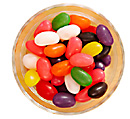 JellyBeans: A History Sweet and Noble JellyBeans: A History Sweet and Noble
by Marjorie Dorfman
Where do jellybeans come from? How did they get to America? Read on for some interesting and very sweet facts.
|
Where did the jellybean come from?
Although the exact origin of jellybeans is not known, many experts believe that a derivative of this popular candy dates back to Biblical times. If you are wondering if there were two jellybeans on board Noah’s Arc, there is no way to authenticate that here (and how they managed to reproduce will always remain a bit of a mystery). And yet jellybeans are a classic American candy.
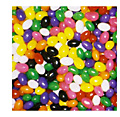 It is known that an offshoot of the soft-centered jellybean was a confection known as Turkish Delight, which originated in Istanbul, Turkey. Technically not a jellybean, it was however, a candy with a firm outer shell and a soft chewy center. The soft, round jellybean is an offshoot of Jordan Almonds or confetti, as it is sometimes known (Aliases are necessary for many indulgers are ashamed of their "sweet teeth" and need to keep them secret from an unforgiving world and many dentists.) It is known that an offshoot of the soft-centered jellybean was a confection known as Turkish Delight, which originated in Istanbul, Turkey. Technically not a jellybean, it was however, a candy with a firm outer shell and a soft chewy center. The soft, round jellybean is an offshoot of Jordan Almonds or confetti, as it is sometimes known (Aliases are necessary for many indulgers are ashamed of their "sweet teeth" and need to keep them secret from an unforgiving world and many dentists.)
Jordan Almonds are manufactured by a process known as panning, which dates back to 17th-century France and has not really changed over the centuries. Raw nuts are placed in a bowl filled with sugar and syrup are actually rocked back and forth until the almonds are completely coated. Originally the process of rocking was done completely by hand, today it is totally automated. (It is not known for sure, but highly suspected that this may be the real origin of that phenomenon known as rock ‘n roll.)
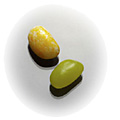 The pairing of the panning process and the modern jellybean cannot be pinned down to an exact time, but candy historians feel that this most likely occurred in the mid 19th century. The earliest recorded advertisement was made by William Schraft in which he promoted sending these treats to Civil War soldiers. (Although the treats came in many different colors, no blue and grey beans were issued. This went across enemy lines and tastes.) The pairing of the panning process and the modern jellybean cannot be pinned down to an exact time, but candy historians feel that this most likely occurred in the mid 19th century. The earliest recorded advertisement was made by William Schraft in which he promoted sending these treats to Civil War soldiers. (Although the treats came in many different colors, no blue and grey beans were issued. This went across enemy lines and tastes.)
Jellybeans were the very first bulk candy and from the early 1900s they became a staple penny candy sold by weight. It wasn’t until the 1930s that jellybeans became an integral part of the Easter season. Egg-shaped, they were the perfect metaphor of fertility and birth. They continue to be an American favorite and approximately 14 billion were sold last year alone. Put another way, if you lined the beans up end to end, they would circle the globe three times! (An amazing feat for a candy!)
In the early years of the twentieth century from about 1910 into the early 1920s, a "Jellybean" in US slang signified a young gigolo or dandy who dressed stylishly, but had nothing else going for him. It was also used as a synonym for pimp and the expression was memorialized in the song, "Jelly Bean" (He’s a Curbstone Cutie)," which was written in 1920 by Jimmy Dupre, Sam Rosen and Joe Verge and kept popular well into the 1940s by Phil Harris.
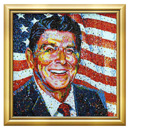 |
|
Portrait made
of jellybeans
|
A "jellybean" in the semi conductor industry refers to a component that is widely available and often used generically. When Ronald Reagan was president, he was known for keeping a jar of jellybeans on his desk and in almost every room of the White House as well, and there’s no question that this increased the candy's popularity among the American people (both parties). How many people know that many jellybeans were even taken into space! On one of the space shuttles they became snack food for the astronauts!
The Jellybean in modern culture
The jellybean has sweetly seeped its way into modern culture both as a word and as an icon. In the film, Ant Bully, these beans are referred to as "sweet rocks" and in Disney’s, Toontown Online, they were used as currency. F. Scott Fitzgerald even entitled one of his short stories The Jelly Bean. Harry Potter and his friends also indulged in every flavor of jellybean during recess at Hogwarts. Many of the flavors were meant to shock and dare the most intrepid taste buds. Consider earwax, booger, dirt, pepper and vomit.
What are jellybeans made of?
The basic ingredients include: sugars, corn syrup and food starch. Other ingredients such as confectioner’s glaze, beeswax, salt and lecithin (an emulsifier) are also part of the final mix although they are present only in minor amounts. Natural and artificial flavors and colors may include: chocolate, coconut, fruit puree or juice, peanuts, vanilla, oils, cream or freeze-dried egg, milk or fruit powders.
In the early days, jellybeans were sold by the color. This made them extremely popular during the holiday seasons because vendors could sell specific holiday-related colors to their customers. Jellybeans remained unchanged with their semi-hard shell and soft chewy center until the mid 1970s when the Herman Goelitz Candy Company changed its history forever.
The Goelitz Company is credited with transforming the jellybean into a delicacy by creating unusual flavors. From this point on, one could buy jellybeans that tasted like watermelon, pears or even tutti-frutti. (With Scratch ‘n Sniff jeans apparel, for example, one can mix and match aromas even while walking down the street!) Jellybeans now not only tasted different, they took on a new appearance as well. Some of them lost their classic clear chewy center, which was replaced by colored and flavored centers.
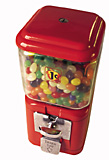 The future of the jellybean The future of the jellybean
The jellybean is an evolving phenomenon and is still a work in progress. Each year, more and more creative flavors hit the market, crashing palettes and tingling taste buds all over the world. Although the future of anything can only be a matter of speculation, it does seem evident that for the jellybean all things are bright, beautiful, sweet and very very…tasty!
Happy jellybean to all and to all a good…dentist’s visit!
Did you know . . .
|
|
|
|
 |
|
|
|
|
Don't miss this excellent book:
Candy: The Sweet History
by Beth Kimmerle
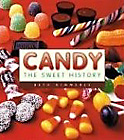
A candy saleswoman, developer and consultant, Kimmerle pays homage to the sweets industry in this colorfully designed history. Recounts in loving detail the evolution of American candy, including lush four-color reproductions of classic advertisements and packaging. Great pictures – a real trip down memory lane. Along with a few handmade treats from the recipe section, a wonderful and unique holiday gift, but like your favorite candy, don't share it unless you've got one for yourself!
|

Click for a printer friendly version of this article.
|
|